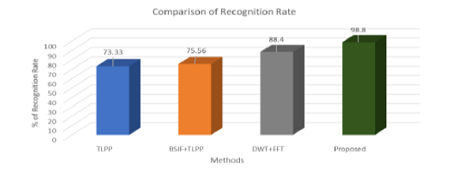


Indian Journal of Science and Technology
DOI: 10.17485/IJST/v14i42.1316
Year: 2021, Volume: 14, Issue: 42, Pages: 3144-3156
Original Article
H C Shanthakumar1, G S Nagaraja2, Mustafa Basthikodi3*
1Computer Science and Engineering, SJBIT, (Research Scholar, Jain University), Bengaluru, Karnataka, India
2Computer Science and Engineering, RV College of Engineering (IEEE Senior Member), Bengaluru, Karnataka, India
3Computer Science and Engineering, Sahyadri College of Engineering & Management, Mangaluru, Karnataka, India
*Corresponding Author
Email: [email protected]
Received Date:16 July 2021, Accepted Date:19 November 2021, Published Date:10 December 2021
Objectives: The main objective is to propose a multimodal biometric system by forming a fusion of Face and Speech modalities using DTCWT+QFT techniques for face and MFCC+RASTA Techniques for Speech recognitions. The experimental results are compared with existing works and analysed the performance with counterparts. Methods: The proposed model, make use of DTCWT and QFT techniques to extract the features of face images and perform fusion of both. The MFCC and RASTA techniques are implemented to extract features of speech data and then fusion is applied. Various databases discussed and utilized for both face and speech recognition system proposed. Findings: The results of experimentation are compared with existing systems and analysis proved than the proposed system is placed in better position. The fusion of DTCWT and QFT techniques for face recognition system is implemented and the results using performance parameters such as False Acceptation Ratio (FAR), False Rejection Ratio (FRR), Total Success Rate (TSR), Partial Error Rate (PER), Equal Error Rate (EER) are tabulated for six different types of face data sets. The average performance of the results is compared with four existing fusion techniques and showed that the proposed system performs better. The fusion of MFCC and RASTA techniques for speech recognition system is implemented and the performance is measured by calculating accuracy, precision, recall and F1-score. These results are compared with five different schemes and proved that proposed system of fusion of face and speech traits works better for human recognitions. Novelty: Fusion of two algorithms for face recognition is implemented and the results analysed. Then the fusion of two algorithms for speech recognition is implemented and the results are analysed. The novel approach is presented to combine both face and speech recognition system in to single system to improve the security using multimodal biometrics.
Keywords: DTCWT; QFT; RASTA; MFCC; Feature Extraction; Fusion
© 2021 Shanthakumar et al. This is an open-access article distributed under the terms of the Creative Commons Attribution License, which permits unrestricted use, distribution, and reproduction in any medium, provided the original author and source are credited. Published By Indian Society for Education and Environment (iSee)
Subscribe now for latest articles and news.